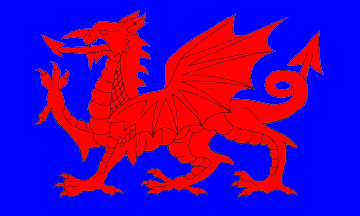
Last modified: 2014-10-25 by francisco gregoric
Keywords: comodoro rivadavia | rawson | sarmiento (domingo faustino) | oil rig | sun: setting |
Links: FOTW homepage |
search |
disclaimer and copyright |
write us |
mirrors

Comodoro Rivadavia is a city of c. 73 000 inhabitants located in
Patagonia, in the South of province of Chubut,
where oil is extracted. The black device on the right of the flag is an oil
extractor (there might be a more specific technical term to designate this
device). The three other black device on the left of the flag look like
electric windmills. It would make sense since Patagonia is known for its
violent winds.
Bernardino Rivadavia (1780-1845) was the first President of the Republic
of Argentina (1826-1827). In 1880, his birthdate was declared National
Day.
Ivan Sache, 03 Mar 2002

There is a short article about this in the current issue of the Flag Institute magazine, Flagmaster 110 [fLm]. There used to be


The municipality of Rawson (22,493 inhabitants in 2001) is the capital of the Chubut Province.
Rawson was settled in in July 1865 by 150 Welsh colonists coming from Puerto Madryn. On 15 September 1865, Colonel Julián Murga, the
Military Commander of Patagonia, hoisted the Argentine flag in the new town. The new settlement was named Trerawson (in Welsh, Rawson
Village), subsequently shortened to Rawson, as a tribute to Guillermo Rawson (1821-1890) the Minister of the Interior (1862-1868) who had initiated the colonization. Antonio Oneto was appointed in 1876 the first Commissioner of the colony. The Chubut National Territory was established on 16 October 1884 by Law No. 1,532; Luis Jorge Fontana was appointed first Governor of the territory on 30 May 1885.The Municipal government of Rawson was established on 14 September 1888, presided by Gregorio Mayo. The Constitution adopted in 1957 established the Chubut Province, with Rawson as its capital.
The flag of Rawson, designed by Patricio Mouján, is prescribed by Municipal Ordinance No. 6,911, adopted on 31 August 2010 by the
Municipal Council.
The flag is horizontally divided white-green by a blue horizontal stripe ending in a blue triangle placed along the fly, charged with a yellow boat. In the middle of the flag is placed a white disk fimbriated black, charged with an iron bridge surrounded at the top by a half yellow sun and at the bottom by a gear wheel.
White represents purity and the plateau, while green represents the valley, the farms and hope in the future. The two colours symbolize the epos of the Welsh colonization.
The blue stripe and triangle symbolize river Chubut watering the town and flowing into the sea; the boat represents the fishing industry.
The disk represents the town. The bridge is the Poet's Bridge, inaugurated in 1918, representing union and the town of Rawson. The
sun represents future and the Chubut Province, while the gear wheel represents industry.
Ivan Sache, 23 Nov 2012

The municipality of Sarmiento (8,028 inhabitants in 2001) is located in the extreme south of the Chubut Province (Patagonia), 160 km east of Comodoro Rivadavia. Founded on 21 January 1897 as a Welsh colony and, therefore, one of the oldest towns in Patagonia, Sarmiento is the capital of the Department of the same name (14,563 sq. km). Sarmiento is the closest town to the "Bosque Petrificado José Ormachea" (Petrified Forest José Ormachea), the biggest fossil forest in the world.
The town, formerly known as Colonia Sarmiento, was named for Domingo Faustino Sarmiento (1811-1888), President of the Republic in 1868-1874.
The flag is modelled on the Argentine national flag, the white stripe being shaped like Mt. San Bernardo, the geographic identification of the town. The white stripe is separated from the lower celeste blue flag by a "Tehuelche guard", black with X-shaped white elements, recalling the native peoples who already lived there 12,000 years ago.
The 17 white stars (seven forming an arch in the upper part of the flag, another ten forming a horizontal line in the lower part of the flag) represent the 17 settlements at the origin of Sarmiento and the melting pot constituted by the town.
Along the hoist, a green vertical stripe represents the fertile valley surrounding the town; along the fly, a brown vertical stripe
represents the Patagonian steppe. The two "guards" located on both ends of the flag are a symbol of protection, modelled on the concept of the protection halo provided by the gods shown on the natives' cloth.
The flag is hoisted in the room of the Municipal Council, together with the flags of Argentina and of the Chubut Province. It is also used outdoors in official ceremonies.
Ivan Sache, 1 Oct 2012
Anything below this line was not added by the editor of this page.